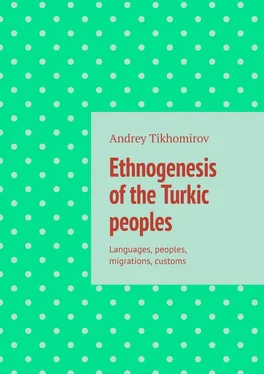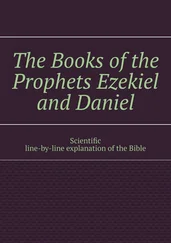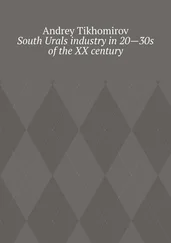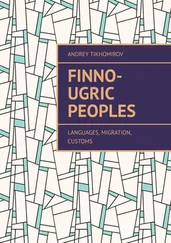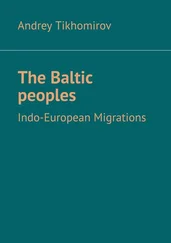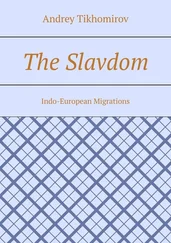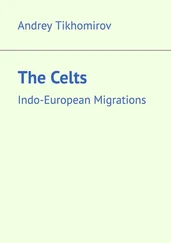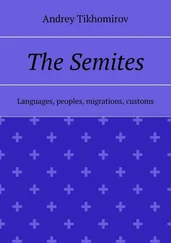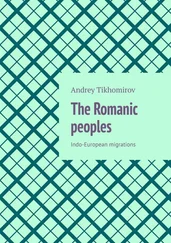Ethnogenesis of the Turkic peoples
Languages, peoples, migrations, customs
Andrey Tikhomirov
© Andrey Tikhomirov, 2020
ISBN 978-5-4498-2385-4
Created with Ridero smart publishing system
Migration of Turkic peoples
In the process of development of Turkic languages and peoples – their carriers, dialects and languages were formed, characterized, on the one hand, by similarities – as a result of the unity of their origin, and on the other – by differences, which are explained by the collapse of the common Turkic base language, first into dialects, and then into separate languages and groups of languages. Turkic peoples are formed on a vast space in the Altai Mountains and interact with other language groups of peoples: Mongolian, Tunguso-Manchu and Tibetan-Chinese. The word “Altai” itself goes back to the Turkic word “altyn” – “gold”, in Mongolian “alt”. “Altan tobchi” or “Altan tovch” (“golden button” or “golden vault”) is the Mongolian annals of the 17th century. Since ancient times, Altai is famous for its rich deposits of polymetals, iron ore, mercury, as well as gold.
The Turki of Altai subjugated tribes and peoples of various origins, including non-Turkic. Authority, as written sources indicate, was concentrated in the hands of the tribal nobility, which had accumulated huge herds of cattle, looted property and had slaves in its economy. At the head of this feudal-patriarchal association was the kagan. However, among the Altai Turks and peoples subordinate to them the tribal tribe, in many respects still primitive social organization, remained and classes in the modern sense did not exist yet. The state was just an unstable association of related tribes with the same development of the economy.
History of Altai Turks of the 1st millennium A.D. e. known mainly by archaeological and written sources. The main archaeological sources are burials and things discovered in them. At this time, the tradition of burying a person along with a horse and harness for riding is spreading. In the valleys of the Altai Mountains, small stone mounds have been excavated, under which there are quadrangular soil pits. They were put in these pits stretched out on the back of the buried. A horse was buried near the buried. Sometimes graves are marked on the surface only with a ring of stones. In the center of the burial ground there was usually a grave of a noble man, and around there were graves of soldiers or slaves buried with him. The poverty of the latter sharply emphasizes the wealth of the central grave. Along with this, there are large mounds. Burials in them are distinguished by the wealth of inventory and the complexity of the funeral ritual. A quiver with arrows, an iron knife, richly decorated belts, silver vessels with ancient Turkic inscriptions were put in the grave. Skeletons of horses rested behind partitions. Such mounds were discovered in Altai near the village of Katanda, in Tuyakhta and on the Ur river in Kuzbass.
Penetration of cattle breeders – the Turkic-speaking ancestors of the Yakuts to the territory of modern Yakutia came from the Baikal region for a long time, starting from the VI – X centuries. n e., when the Kurykans lived on the Angara and Lena (this is the so-called Kurumchin culture). However, there was a pre-Turkic population of these places. The oldest settlement of the Iron Age found on the river. Yuuke below Yakutsk. The original culture of the early Iron Age of Yakutia is represented by settlements near the village. Mukhtuya above Olekminsk and Siktyakh in the lower reaches of the Lena. The population was engaged in hunting and fishing. The Yakut people formed on the Lena River as a result of the absorption of local tribes by the southern Turkic-speaking immigrants. It is believed that the last wave of the southern ancestors of the Yakuts penetrated the Middle Lena only in the XIV – XV centuries. Some local Yakut groups, such as the Yakut-reindeer herders of the northwest, have arisen relatively recently as a result of the mixing of separate Evenki groups with Yakuts originating from the central regions. In the public life of the Yakuts, there were many remnants of the tribal system, and tribal revenge was preserved. Anthropologically, the Yakuts belong to the Central Asian and Baikal types of the Mongoloid race. According to their habitat, cultural and domestic differences, the Yakuts are divided into a number of local groups – Amgino-Lena, Vilyuisk, Olekminsky, Verkhoyansk, northern. In the economy and material culture of the Yakuts, traits similar to the culture of cattle breeders of Central Asia prevail, but there are also northern taiga elements. In the 20s. XVII century Yakuts were included in the Russian state, which accelerated their socio-economic and cultural development. At the same time, the Yakut masses began to be subjected to brutal yasak oppression, gross oppression by tsarist officials, merchants and furs buyers.
For countries that came to feudalism through the slave system (for example, for China, India, Iran – in Asia, for Italy, France, Spain – in Europe), the transition to feudal relations meant a new step in the formation of nationalities that began to form in ancient times. For countries that came to feudalism directly from the primitive communal system (for example, in Europe – for Germany, England, the Scandinavian countries, Russia, the Czech Republic, Poland, in the East – for some Turkic tribes), the process of forming ethnic groups from tribes and tribal associations began along with the development of feudalism. In a number of tribe groups and associations in Europe and Asia (for example, among the Mongol and some Turkic tribes), the beginning of this process dates back to a relatively late time, to the 11th – 13th centuries.
The ancestors of modern Turks – nomadic Oguz tribes first entered the territory of modern Turkey from the regions of Central Asia, and earlier from Altai, in the XI century. The largest ruler of the Turkish tribes of Osman Bay (ruled around 1281—1324) actually became the founder of the Ottoman (Ottoman) empire. The migration of the ancient Oguzes is mentioned by the Arab geographer al-Adrisi (XII century), who, in his essay “Entertainment of the worn out by wandering by regions” or “Book of Roger”, according to one of the travelers, describes the area of the South Urals, where the river Ruza is mentioned (the Finno-Ugric name of the Yaik River, now the Urals): “… this river is called Ruza. It is a large river, crosses through it on barges… The big river flows (into it – the author), flowing from the north from this river from the large mountains separating the country Guz (Oghuz – author) from the country of Basjirt (Bashkir – Av op) …». And the Guz (Oghuz) are the ancestors of the Turks, Turkmen, Azerbaijanis, Gagauz and Karakalpaks. Wikipedia: “The book of Roger (Arabic.” Al-Kitab ar-Roojari”, lat. Tabula Rogeriana, full name” Nuzhat al-mushtak fi-htirak al-afak”, which translates as” the joy of a passionate person who wants to cross the world”) – comment al-Idrisi to the map of the world famous in his time in the form of a silver planisphere on paper, on which he worked for 18 years at the court of the Sicilian king Roger II.There are three manuscripts of the 14th-15th centuries with the book of Roger, two of which at the National Library of France and one at the Bodleian Library of Oxford.”
Famous Orenburg local historian Chibilev A.A. in the book “The Ural River (Historical and Geographical Essays on the Ural River Basin)”, Leningrad, Gidrometeoizdat, 1987, writes: “When we were in the deep regions of Kazakhstan, we asked the indigenous people why the rivers are called Aksu and Karasu, and were surprised by their deep knowledge toponymy and local environmental conditions. It turns out that giving the name to this or that stove, the lake, the ancient nomads took into account whether they would be able to water cattle in this place, say, in the middle of summer or not. Indeed, in the dry season, temporary flowing rivers dry up, designated in Kazakh by the word ‘axu’, and, on the contrary, ‘streams’ of rivers with ground nutrition ‘karas’ ‘hold’ water. Thus, the names Aksu, Akbulak, Aksai, Akkol, as well as Karasu, Karabutak, Karakol, etc., so widespread in the Ural basin, are characterized not by the color of the water, but by the features of the water regime. These are either ‘flowing’ or ‘ground’ water bodies.”
Читать дальше
